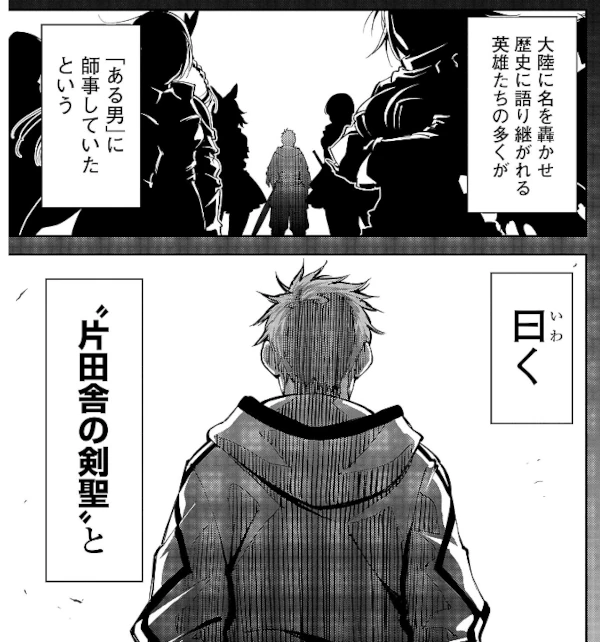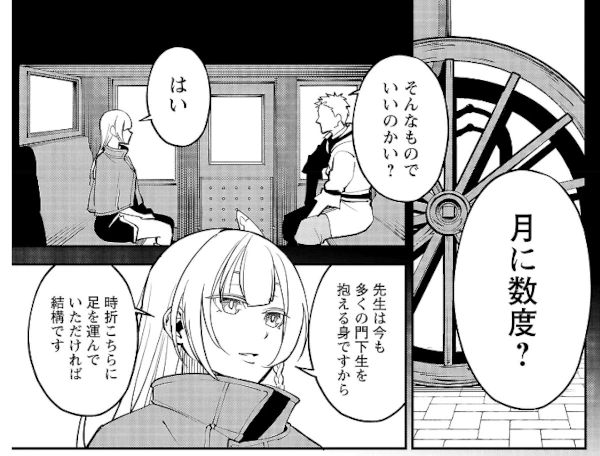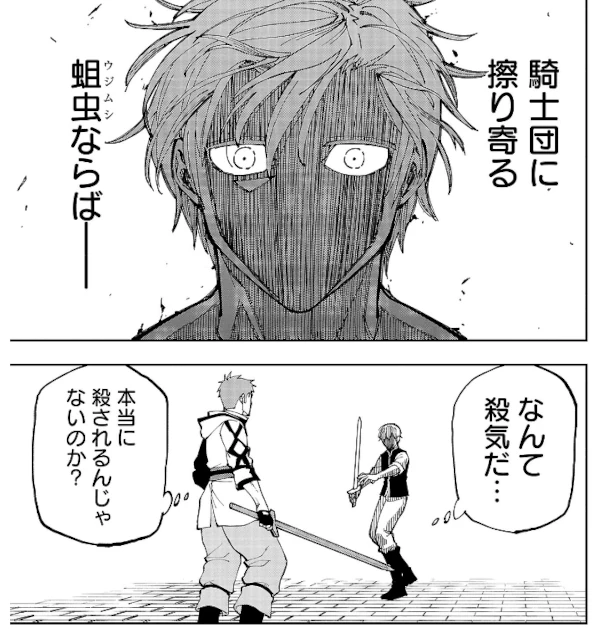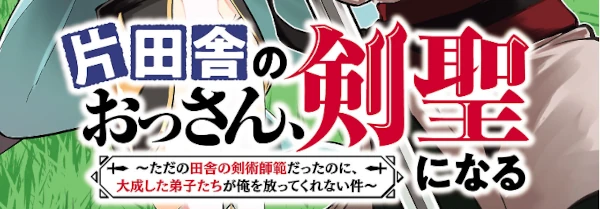This time, we’re introducing From Old Country Bumpkin to Master Swordsman—a fantasy manga where honorific speech meets heroic adventure, perfect for learners who want to master keigo in a fun and uplifting setting.
Work Information

From Old Country Bumpkin to Master Swordsman (片田舎のおっさん、剣聖になる)
Author: Sagazaki Shigeru / Nabeshima Tetsuhiro / Sato Kazuki
Publisher: Akita Publishing
Amount of text: moderate
Challenge level: ★★
Latest volume : Vol.7(Mar.2025 / Ongoing)
Story overview
“I’ve recommended Master Beryl for the position of special instructor to the Royal Knights.” Beryl Gardennant, a modest swordsman who runs a small dojo in a remote village, suddenly finds his quiet life upended. One day, his former pupil Alyucia—now the young captain of the Royal Knights—appears before him with this news. Invited to the royal capital as a special instructor, Beryl reunites with his former disciples, all of whom have become accomplished warriors in their own right. Thus begins the tale of a humble middle-aged man whose skills and spirit lead him toward unexpected glory.
The Appeal of This Manga
This is the ultimate “Cinderella story for middle-aged men.” Beryl, a humble country swordsman, is invited to the royal capital by his former student Alyucia—now a beautiful captain of the Royal Knights. There, he reunites with other former disciples, all striking women with unique personalities who still admire their old master. Though modest and self-doubting, Beryl’s quiet skill wins everyone’s respect, turning each challenge into triumph. A feel-good fantasy born from Shōsetsuka ni Narō—perfect for when you just want to relax and enjoy a heartwarming adventure.

Why this manga is suitable for learning Japanese
This manga is not only entertaining but also highly recommended for Japanese learners for several reasons.
A Fantasy World Rich in Polite Speech
Unlike many recent isekai (otherworldly) fantasy stories, which often rely on casual, conversational Japanese, this series features frequent use of keigo (polite and respectful speech). You’ll notice that younger characters—especially Beryl’s disciples—speak to him using polite or humble language, reflecting their respect for their teacher. For learners, it’s a rare chance to study how keigo naturally functions in fantasy settings.

Easy to Read, with Plenty of Action
Since the protagonist is a swordsman, the story is filled with dynamic battle scenes. The dialogue is concise and not overly dense, making it accessible even for beginner-level Japanese readers. You can enjoy the action while naturally absorbing everyday and polite expressions.

Culture Spotlight
“Long Titles” in Japanese Light Novels: When Fantasy Meets Expressionラノベ原作作品における長文タイトル
In recent years, a new trend has taken over Japanese light novels and web fiction: long, sentence-like titles. Unlike the concise titles once common in literature—such as Naruto or Spirited Away—today’s stories often have titles that look like full sentences.
For example, consider the following light novel:
「片田舎のおっさん、剣聖になる~ただの田舎の剣術師範だったのに、大成した弟子たちが俺を放ってくれない件~」
(“From Old Country Bumpkin to Master Swordsman — I Was Just a Rural Sword Instructor, But My Successful Students Won’t Leave Me Alone!”)
At first glance, it might look excessive. But this style has become a defining feature of the “Narou-kei” (なろう系) boom—stories born from the online fiction platform 小説家になろう (“Let’s Become a Novelist”).

Why the Titles Became So Long
These long titles serve a practical purpose: they act as both summary and advertisement. Since thousands of new stories appear online every day, readers have only seconds to decide what to click. A detailed title instantly tells you:
・Who the main character is
・What their situation or power is
・What kind of emotion or twist to expect
For example:
・“Reborn as a Vending Machine, I Now Wander the Dungeon” (「自動販売機に生まれ変わった俺は迷宮を彷徨う」)
・“I Couldn’t Become a Hero, So I Reluctantly Decided to Get a Job” (「勇者になれなかった俺はしぶしぶ就職を決意しました。」)
・“That Time I Got Reincarnated as a Slime” (「転生したらスライムだった件」)
Each title gives you the premise and the punchline—like a miniature pitch deck in sentence form.
A Mirror of Internet Culture
This trend reflects not only marketing logic, but also the expressive habits of the internet generation. Platforms like Twitter (now X) and web fiction sites value speed, relatability, and humor. Writers use long titles to build an instant connection with readers—casual, emotional, and slightly self-aware.
In that sense, these titles mirror online communication itself: conversational, dramatic, and packed with feelings. They blur the boundary between narrative and meme, between story and self-introduction.
Symbolism Behind the Long Title Boom
The popularity of these titles also hints at deeper cultural themes in modern Japan:
・Self-expression in a modest society:
In a culture that values humility, fiction allows characters (and authors) to express personal dreams boldly.
・Relatability over mystery:
Unlike classical literature, which prized subtlety, modern readers prefer clarity and immediate understanding.
・Escapism and humor:
The exaggerated titles offer both a sense of parody and a promise of emotional release.
Thus, a title like “I Was Just a Rural Instructor, But My Disciples Won’t Leave Me Alone” becomes not just a hook—but a cultural signal:
a gentle rebellion against understatement, and a celebration of personal fantasy.
What It Means for Learners of Japanese
For Japanese learners, this trend is a fascinating example of how language adapts to digital storytelling. You’ll encounter:
・Playful use of grammar and particles (“~の件,” “~してみた”)
・Conversational rhythm in written form
・Blends of humble, polite, and casual tones that reflect the speaker’s personality
By reading these titles and their stories, you can sense how modern Japanese balances clarity, emotion, and humor—not only in speech, but in how stories introduce themselves to the world.
A Little Warning
Beware of the “-ssu” Ending!
The speech ending “-ssu” (〜っす) originally came from athletic students talking politely—but casually—to their seniors. Recently, female characters using “-ssu” have become a trendy trope in manga and games, giving their speech a tomboyish or fresh tone. However, keep in mind that “-ssu” is not appropriate in formal situations. It shows light respect in casual conversation but should not be imitated in real-life business or academic settings.

Work Information

From Old Country Bumpkin to Master Swordsman(片田舎のおっさん、剣聖になる)
Author: Sagazaki Shigeru / Nabeshima Tetsuhiro / Sato Kazuki
Publisher: Akita Publishing
Amount of text: moderate
Challenge level: ★★
Latest volume : Vol.7(Mar.2025 / Ongoing)
Here’s a safe and convenient way to purchase Japanese manga.
This Blog’s ConceptIn this blog, we are introducing manga that are not only highly captivating but also ideal for Japanese language learners. Studying Japanese through manga is both fun and effective. Manga allows you to understand the subtleties of keigo (honorifics), teineigo (polite speech), and casual conversation in Japanese. We hope you find works that match your interests and use them to enhance your Japanese learning journey.